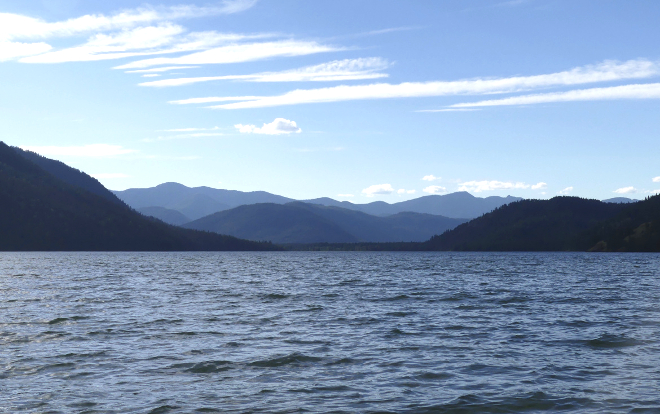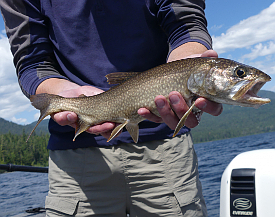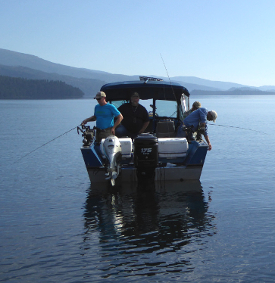
IDFG Public Information Specialist
Fishing at Priest Lake isn’t what it used to be, which is fine for some anglers, but others would like to see it change. Fish and Game wants to know if the current management is still working, or if change is needed.
“We want the anglers to tell us what kind of fishing opportunity they want, which will dictate how we manage Priest Lake over the next 10 to 15 years,” Fish and Game Regional Fisheries Manager Andy Dux said.
Currently, Priest Lake is mostly a lake trout (also known as Mackinaw) fishery, and few of the once-abundant kokanee salmon remain. Native cutthroat trout are available in modest numbers, and native bull trout are nearly gone, except in Upper Priest Lake.
 |
In 2013, Fish and Game formed the Priest Lake Fishery Advisory Committee consisting of local stakeholders representing varying interests. The group worked with F&G staff over the past several years to look at Priest Lake’s current fishing opportunity, and weigh that against its potential.
The committee developed three alternatives upon which F&G is asking anglers to provide their preference:
* Alternative 1: Continue existing management primarily for a sustainable lake trout harvest fishery and continue native fish conservation efforts in Upper Priest Lake.
* Alternative 2: Restore a kokanee fishery capable of supporting high catch rates and harvest while enhancing native cutthroat trout and return to limited cutthroat harvest. Also, increase native bull trout to allow for a trophy fishery, while managing for a low-density lake trout population. Continue native fish conservation efforts in Upper Priest Lake.
* Alternative 3: Provide mixed-species fishing opportunity by reducing the lake trout population to support moderate catch rates and harvest while allowing kokanee to reach moderate densities and provide moderate catch rates. Provide conservation benefit and improve fishing for native cutthroat and bull trout. Continue native fish conservation efforts in Upper Priest Lake.
The department is hosting three public meetings in July, and you can see below for details on times and locations. F&G will also conduct a random survey of license-holders and an online opinion poll in late-summer or fall.
Why only three alternatives?
The Priest Lake Fishery Advisory Committee was tasked with developing a short list of alternatives for broader public consideration. At first, each committee member had a separate alternative, then the members worked to find common ground, make modifications and settle on three options.
Fish and Game staff provided technical guidance, which helped to focus on ideas that were most feasible and would provide the desired fishing opportunities.
Fisheries managers did not advocate for a particular option. They spent years working on the successful kokanee restoration on Lake Pend Oreille and shared with the committee some of the valuable lessons they learned in the process. Even with this guidance and experience, the alternatives for Priest Lake still face challenges and have risks.
A brief history of Priest Lake’s fishing
 |
Kokanee not only provided great fishing for anglers, the fish were also an important food source for bull trout and lake trout, which attained trophy sizes. That balance of predators and prey fish lasted into the 1970s, then quickly fell apart.
Mysis, a small freshwater shrimp, was introduced in the late-1960s to provide more food for kokanee.
Unfortunately, mysis tipped the balance in favor of lake trout, which feed on shrimp until the fish grow big enough to switch their diet to kokanee.
Mysis allowed the lake trout population to grow at the expense of kokanee, whose population crashed in the mid-to-late 1970s and have never recovered. This also happened to a lesser extent as lake trout preyed on, or outcompeted, cutthroat and bull trout. That is why Fish and Game tries to curb lake trout populations in Upper Priest Lake to relieve pressure on those native fish.
Fish and Game previously attempted to boost kokanee numbers by stocking more of them, but those efforts were thwarted by predation by the lake’s abundant lake trout. Millions of kokanee fry, as well as hundreds of thousands of juvenile cutthroat, were stocked, but to no avail.
“You have too many lake trout mouths to feed, and the kokanee disappear as soon as you put them in,” Dux said.
Are lake trout bad?
It is easy to argue that the establishment of lake trout in Priest Lake was a bad thing, but having a lake trout-dominated fishery now isn’t necessarily good or bad.
Lake trout caused declines in native cutthroat and bull trout, and collapsed the popular kokanee fishery. However, the damage they caused is largely done, and what remains is a different fishery that generates about half the angler effort on Priest Lake that it historically had.
But lake trout are a desirable sport fish for many anglers, and since the 1980s, Fish and Game has managed the Priest Lake primarily for lake trout, while focusing on conserving native fish in Upper Priest Lake.
Maintaining the current fishery is an acceptable option, so long as anglers understand what fishing will be like. In the presence of lake trout, kokanee will remain depressed except in occasional years, such as 2012, when they bumped up a bit before crashing again. Good kokanee fishing will remain sporadic and fairly unpredictable.
Lake trout are far more abundant than they were historically, offering a consistent fishery with good catch rates for anglers who target them. However, frequency of the trophy-sized lake trout has dropped from decades ago because although mysis provide a stable forage, they don’t provide enough nutrients for lake trout to reach trophy sizes.
The average lake trout is currently about 15 to 25 inches, and it generally takes 10 to 20 years for them to reach those sizes. While average size has declined, these mysis-fed lake trout have bright orange filets that are excellent table fare for anglers.
For anglers who like targeting native cutthroat trout, the existing fishery will likely offer good catch rates into the future. However, the cutthroat population will provide limited or no harvest opportunity at current levels. Bull trout are essentially nonexistent in the main lake, so they will only be encountered in Upper Priest Lake, and no harvest is allowed.
Parallels between Priest and Pend Oreille
Part of the interest many anglers have in changing Priest Lake’s fish management is the success of restoring kokanee at Lake Pend Oreille. That lake had a similar situation with a collapsed kokanee fishery following an increased lake trout population.
Fish and Game did an extensive, multi-year project to dramatically reduce lake trout and afterward saw a rapid resurgence of kokanee. The kokanee fishery was reopened, and angling effort quickly expanded. Now, anglers are catching lots of kokanee, while others are still catching a few large lake trout and Pend Oreille’s famed trophy rainbows.
“Lake Pend Oreille is a case study that provides us with the confidence we can bring back a fishery like what Priest Lake previously supported,” Dux said.
After the recovery of kokanee at Pend Oreille, some anglers asked Fish and Game to do something similar at Priest Lake. However, other anglers value having the option to either pursue kokanee at Pend Oreille, or lake trout at Priest Lake.
That’s why fisheries managers want to learn if there’s a majority of anglers who prefer one over the other that would trigger a management change at Priest. If change is preferred, managers can determine the best strategy, what it would cost, and how to pay for it.
Sometimes a happy medium isn’t so happy
The obvious answer may seem to be splitting the difference and somewhat reducing the lake trout population in an attempt to grow more kokanee. Theoretically, it’s possible and likely would produce a fishery that appeals to the greatest number of anglers.
Unfortunately, this alternative is the least predictable. It’s difficult to know how much of a reduction in the lake trout population would be needed to produce a corresponding gain in kokanee, or how long it would last.
What’s likely to occur is a short-term see-saw between those species, a fishery that is less stable, and a constant challenge of determining the right number of lake trout to remove in order to balance the predator-to-prey ratio.
Biologists know despite short-term fluctuations, long-term conditions would still favor lake trout, so it would likely require constant, and potentially expensive, management for a modest change in the ratio between lake trout and kokanee.
“We don’t have a great track record of being able to manage for a balance between predator and prey in these big lakes systems, particulary without the level of resources we had available on Lake Pend Oreille,” Dux said.
However, if there’s an overwhelming desire for that option, biologists would do their best to make it happen.
What if nothing is done?
Simply put, the lake’s fisheries will remain mostly as they are now. Fishing will be mostly for lake trout, and their average size will remain in the 15-to-25 inch range with an occasional larger one, but Priest Lake is unlikely to produce many of the trophy-sized lake trout it had in the past.
The small population of kokanee will likely persist, and in rare years when conditions favor them, there will be a modest, but short-term, blip in the population. Fish and Game and its partners will continue to protect cutthroat and bull trout in Upper Priest Lake.
"This is the most predictable and easiest alternative to implement," Dux said. "The current fishery certainly is good in the eyes of many anglers, and if this option has broad support, Fish and Game will stay the course with existing management."
Public involvement opportunities
Anglers and others interested in the management planning process for Priest Lake have several opportunities to comment.
Public meetings will be held:
* Thursday, July 13, 6:30 p.m., The Inn at Priest Lake, Coolin.
* Monday, July 24, 6:30 p.m., Priest River Events Center, 5399 U.S. 2, Priest River.
* Thursday, July 27, 6:30 p.m., IDFG Panhandle Region Office, 2885 West Kathleen Avenue, Coeur d’Alene.
Later this summer, Fish and Game will mail out surveys to a randomly selected number anglers, and at the same time, make an online poll available on Fish and Game’s website, https://idfg.idaho.gov, for whoever wants to take it. Fisheries managers plan to make a decision on how to proceed with the lake’s management by the end of 2017.